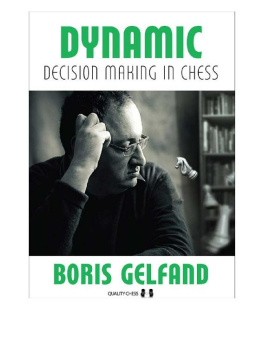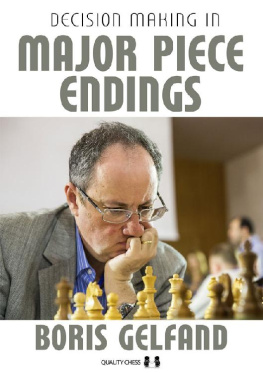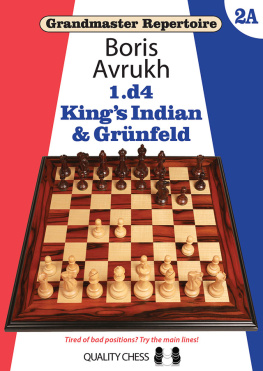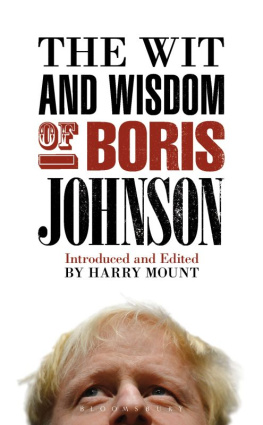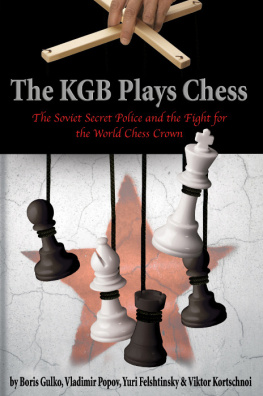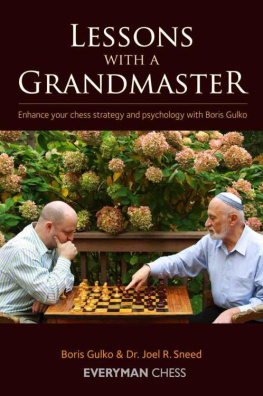Boris Gelfand - Dynamic Decision Making in Chess
Here you can read online Boris Gelfand - Dynamic Decision Making in Chess full text of the book (entire story) in english for free. Download pdf and epub, get meaning, cover and reviews about this ebook. year: 2017, genre: Art. Description of the work, (preface) as well as reviews are available. Best literature library LitArk.com created for fans of good reading and offers a wide selection of genres:
Romance novel
Science fiction
Adventure
Detective
Science
History
Home and family
Prose
Art
Politics
Computer
Non-fiction
Religion
Business
Children
Humor
Choose a favorite category and find really read worthwhile books. Enjoy immersion in the world of imagination, feel the emotions of the characters or learn something new for yourself, make an fascinating discovery.
- Book:Dynamic Decision Making in Chess
- Author:
- Genre:
- Year:2017
- Rating:3 / 5
- Favourites:Add to favourites
- Your mark:
- 60
- 1
- 2
- 3
- 4
- 5
Dynamic Decision Making in Chess: summary, description and annotation
We offer to read an annotation, description, summary or preface (depends on what the author of the book "Dynamic Decision Making in Chess" wrote himself). If you haven't found the necessary information about the book — write in the comments, we will try to find it.
Dynamic Decision Making in Chess — read online for free the complete book (whole text) full work
Below is the text of the book, divided by pages. System saving the place of the last page read, allows you to conveniently read the book "Dynamic Decision Making in Chess" online for free, without having to search again every time where you left off. Put a bookmark, and you can go to the page where you finished reading at any time.
Font size:
Interval:
Bookmark:

Contents
Title Page
Key to Symbols used 4
Publishers Foreword 5
Introduction 7
1 Minsk 1979 19
2 Petrosian 33
3 Tactics at the Top Level 47
4 The Nature of Tactical Mistakes at the Top Level 79
5 Compensation 121
6 Time 151
7 Dynamic Masterpieces 197
8 Dynamic Defence 241
Appendix Borenka will Remember! 273
Name Index 278
Game Index 281
Opening Index 283

Dynamic Decision
Making in Chess
by
Boris Gelfand
with invaluable help from Jacob Aagaard
Quality Chess
http://www.qualitychess.co.uk
First edition 2016 by Quality Chess UK Ltd
Copyright 2016 Boris Gelfand
DYNAMIC DECISION MAKING IN CHESS
All rights reserved. No part of this publication may be reproduced, stored in a retrieval system or transmitted in any form or by any means, electronic, electrostatic, magnetic tape, photocopying, recording or otherwise, without prior permission of the publisher.
Hardcover ISBN 978-1-78483-013-7
All sales or enquiries should be directed to Quality Chess UK Ltd,
Suite 247, Central Chambers, 11 Bothwell Street,
Glasgow G2 6LY, United Kingdom
Phone +44 141 204 2073
e-mail: info@qualitychess.co.uk
website: www.qualitychess.co.uk
Distributed in North America by National Book Network
Distributed in Rest of the World by Quality Chess UK Ltd through
Sunrise Handicrafts, ul. Poligonowa 35A, 20-817 Lublin, Poland
Typeset by Jacob Aagaard
Proofreading by Colin McNab & Andrew Greet
Edited by John Shaw
Cartoon on page 13 by kind permission of Jos Diaz
Photo page 47 courtesy of Biel Chess Festival
Official FIDE photos by Anastasia Karlovich pages 79, 273
Photos pages 151 and 241 by Ilya Odessky
Photo page 197 by Maya Gelfand
Photos and illustrations on pages 274-277 by Max Meltser
Cover design by adamsondesign.com
Cover photo by Fred Lucas; effects by Max Meltser
Key to symbols used
White is slightly better
Black is slightly better
White is better
Black is better
+
White has a decisive advantage
+
Black has a decisive advantage
=
equality
with compensation
with counterplay
with an initiative
unclear
?
a weak move
??
a blunder
!
a good move
!!
an excellent move
!?
a move worth considering
?!
a move of doubtful value
only move
#
mate
Publishers Foreword
The last few years have been everything I could ever dream of as a chess writer. My books are selling enough for me to buy new soles for my second-hand shoes, readers from all over the world are telling me that they enjoyed the books, and strong players are even pretending that they were useful for them in their tournament preparation.
But the biggest joy has been working with Boris Gelfand on this project. Boris loves chess immensely and it is impossible not to fall in love with the game all over again when discussing it with him. Our analysis sessions have been spirited and enjoyable, and I have been able to learn a lot about the game from them, all of which is hopefully included in this book!
Writing a book is a difficult job, even when it is co-writing. You still have to choose the right words, structure, restructure and then restructure some more. A point made in August might be easier to understand if added to a game analysed in February. You get the idea. When the ideas are not in your head, but in someone elses, this does not become an easier process.
What has made writing these two books amazing is the time spent with Boris. His warmth and wit dominate our conversations. I laugh more in our sessions than at any other time during a normal week. I will leave you with one extract from one of our conversations in 2014:
Boris: Hi Jacob, how are you?
Jacob: Good thank you, and you?
Boris: Is it raining in Scotland?
Jacob: What do you mean?
Boris: Water falling from the sky.
Jacob: Well, its Scotland. It is always raining a little bit.
Boris: Here we had no rain for two weeks. How warm is it?
Jacob: Heat wave.
Boris: What does this mean, heat wave?
Jacob: Eighteen degrees.
Boris: Ha! Here it is thirty-five degrees.
Jacob: ...
Boris: You should come and visit!
Jacob: ...
Then our conversation was interrupted. A siren rang out weakly somewhere outside Boriss house. He stood up immediately.
Boris: Sorry, I will be back in ten minutes.
Boris returned ten minutes later.
Boris: So, Jacob. Is it still raining in Scotland?
Being a part of this project is an ongoing joy. I hope some of this joy has spilled over into the pages and makes this not only an instructional book, but also a pleasure to read.
Jacob Aagaard
Glasgow, May 2016
Introduction
At the beginning of this year, I played in a rapid tournament in Estonia. I won one game where my opponent, an old room-mate from training camps with Petrosian, failed to show up. He came up to me later and apologized. He had been very excited about playing against me, and got so caught up in the preparation for the game that he lost all sense of time. When he finally looked at the clock, the game was already over, and he was still in his room...
Chess is all about time. Each player makes a move, choosing to move only one piece, hoping that all his pieces will be in time to reach the necessary squares. If you are late, the opponent will checkmate you, queen his pawn, take your knight, skewer your rook or maybe just run away with half the kingdom and all three princesses.
Chess is also about handling the clock. Before each game you are entrusted with a certain amount of time, and you have to do your best to spend it wisely.
This book is about dynamics. The things that easily fall victim to time, have an unstable foundation, and erode quickly.
This is not an academic textbook about dynamics; it is a deeply personal book, with dynamics as the central theme.
Other recurring themes I shall discuss include the influence of engines on modern chess, and the clash between the millennials and my generation, both in chess style and in the public imagination. But if I think one of my experiences or opinions will interest the reader, then I shall mention it, even if it is off-topic. If you can survive these digressions, you will be less shocked later in the book when a recipe for strawberry jam appears...
Early investigations
I worked with Eduard Zelkind until I was 11 years old. At this time, he moved to the US and asked his friend Albert Kapengut to look after his best student. Ilya Smirin arrived later on, when he moved to Minsk to study at the university in the second part of the 1980s.
I was maybe six or seven when Zelkind gave me tactical exercises to solve at home, sacrifices on h7 and other such basic stuff. I had not learned to read and write yet, so my father would write down the positions and the solutions for me, so I could bring them to the next training session. This continued until I learned to read and write myself. Zelkind had his own system for writing down positions in the most effective way, which others might look at as an unbreakable code.
At this time there was no access to such luxuries as a photocopying machine. All exercises would have to be written down by hand at the end of the lesson.
Next pageFont size:
Interval:
Bookmark:
Similar books «Dynamic Decision Making in Chess»
Look at similar books to Dynamic Decision Making in Chess. We have selected literature similar in name and meaning in the hope of providing readers with more options to find new, interesting, not yet read works.
Discussion, reviews of the book Dynamic Decision Making in Chess and just readers' own opinions. Leave your comments, write what you think about the work, its meaning or the main characters. Specify what exactly you liked and what you didn't like, and why you think so.

